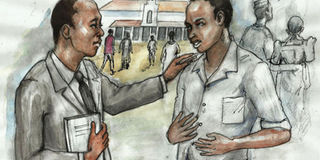Linking a weapon to the death

What you need to know:
Part III. It is important to link a weapon to the death in question. In the case we have been following, the panga suspected to have caused the death blow had been overlooked.
ALSO READ: Linking a weapon to a death 2
On June 2, 1994, the Supreme Court of Uganda, at Mengo, upheld the conviction and sentence of the High Court in Masaka in respect of Charles Rwamunda, who had been convicted of manslaughter and sentenced to concurrent terms of 12 years, after he was found guilty of having unlawfully caused the deaths of two persons, his aunt, Matilda, and her husband.
Matilda died one month after she had been cut with a panga on her head. Matilda’s death was attributed to an abscess that had formed in the brain. Her husband died on the night they were attacked and the cause of his death was recorded as blood loss from the wounds he sustained.
One of the grounds of appeal that Charles Rwamunda’s lawyers raised was that the panga, which is alleged to have been used during the attack and exhibited in court had not been identified beyond reasonable doubt and that the panga had not been subjected to a forensic examination to establish if, indeed, it had the blood of Matilda and her husband on it.
Supreme court ruling
The Supreme Court’s ruling on this matter was that: It must be invariable practice for the prosecution and court to show the alleged murder weapon to the doctor, for his opinion to be recorded whether it is or is not consistent with the wounds on the deceased, if the weapon is accepted as such by Court
Also, that prosecutors and judges alike, should not resort to loose statements such as the panga “appeared to be blood stained”, unless there is evidence that that fact has been proved by the government chemist, or an eye witness who actually saw the blood on it to be the result of the blow.
Lapse in time
Another ground of appeal was that there was also the lapse of time from the incident of the attack to the death, and there was no evidence to explain what happened during this interval.
On this, the Supreme Court ruled that when a doctor has been treating a patient while alive, that doctor should not carry out the postmortem examination.
A fresh opinion is necessary as to the cause of death. It is also necessary to ascertain whether there had been any intervention exonerating the accused person.
A related case
In an earlier and related case, on September 4, 1992, Fred Kamanzi led a gang of attackers into a house and cut the occupant of the house with a panga on the head. Kamanzi was arrested at the scene of crime and the injured man was taken to hospital, admitted and treated. He was discharged, but about one month later, he died at his home.
According to the postmortem report, the body of the deceased had a cut wound on the scalp and also pus discharge from the nose and mouth. The cause of death was stated as an infection of the brain that was a complication of internal brain hemorrhage.
The trial judge convicted Kamanzi for murder and the Court of Appeal upheld the trial’s court’s decision.
Supreme court ruling
Kamanzi appealed to the Supreme Court and one of the grounds of the appeal was that the prosecution did not discharge the burden of proof beyond reasonable doubt that the injury sustained by the deceased was the direct cause of his death.
The Supreme Court in this case held that: It was not clearly established by the postmortem examination that the external wound on the scalp of the deceased was the direct and immediate cause of the internal hemorrhage that later became infected.
That there was a lacuna in the evidence of the prosecution as to whether the internal brain hemorrhage resulted from the cut wound or another cause wholly unconnected with the injury. The onus was on the prosecution to prove beyond reasonable doubt that the infection seen by the doctor had resulted from the cut wound.
That the doctor who performed the postmortem should have been summoned to testify and clarify on the relationship between the infection, the internal hemorrhage and the wound on the scalp or if the infection was the result of other causes.
That the onus was on the prosecution to rule out any possibility of the death having come about by some other circumstances wholly unconnected with the injury inflicted by the appellant.
The Court of Appeal erred to say that they were unable to say that some other causes intervened when the prosecution had failed to prove beyond reasonable doubt that the cause of death followed directly from the wound inflicted by the appellant.
The legal principle is therefore that it is not enough to establish that an accused person caused an injury but prosecution must also prove that that very injury and not any other cause led to the death of the deceased.




